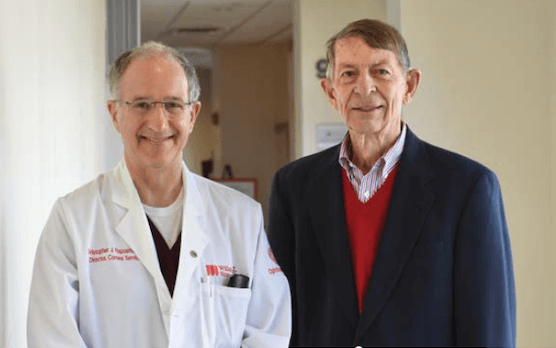Ken Gray
Philanthropist Ken Gray Shares Experience as
RECIPIENT OF CORNEAL TRANSPLANTS
Over 15 years ago, Ken Gray noticed that his vision wasn’t quite right even after an adjustment to his eyeglass prescriptions. It was particularly apparent when driving, working, or trying to steer his sailboat. “I wasn’t focusing sharply,” remembered the 88-year-old Haverford, Pennsylvania resident. “I was referred to physicians at Wills Eye Hospital.” Although it was discovered that he had cataracts — commonplace for someone of his age — he was also diagnosed with Fuchs corneal dystrophy.
According to Christopher J. Rapuano, MD, Director of the Cornea Service: “Fuchs corneal dystrophy is an uncommon eye disorder that often runs in families. It causes the cornea to swell and lose its transparency, resulting in blurry or loss of vision. It often has a genetic component, but not always, and is one of the most common reasons for a corneal transplant in the United States and many countries around the world.”
Ken was a candidate for corneal transplants, but first underwent cataract surgery. Dr. Rapuano performed the DSEK procedure on the left eye in 2013 and the right eye in 2019. “DSEK is short for Descemet’s stripping endothelial keratoplasty,” explained Dr. Rapuano. “Only the back layers of a patient’s cornea are removed. A similar portion is then fashioned from a donor’s cornea and placed into the eye. It requires 0 to 3 sutures and vision recovers in a few weeks to months.”
“I am extremely pleased with the results,” said Ken, reflecting on the short recovery time and excellent care he received in both the Cataract and Primary Eye Care Service (CPEC) and the Cornea Service.

When Ariel Chen, MD, began her cornea fellowship at Wills Eye Hospital in July 2022, she was anticipating the challenge of diagnosing and treating an array of corneal infections and diseases. She also knew there would be patients requiring corneal transplants, as Wills Eye physicians perform hundreds every year. “The volume and diversity is so much more than what I expected,” said Dr. Chen. “It’s been an amazing experience and I’m shocked by how much I learn every day — medically, as far as managing patients, and surgically — with the many different approaches by attendings.”
Dr. Chen’s sentiments are echoed by the two other Cornea Service Fellows: Nick Hadjokas, MD, and Patrick Burbano, MD. The fellowships are made possible because of the generosity of donors, such as Ken Gray, Executive Trustee of the Gray Charitable Trust. “I’m fortunate that we have been able to fund the fellowship,” said Ken, who runs the trust with his wife, Doreen, their daughters, Kimberley and Meridith, and a long-time family friend. “I think it’s very important to train physicians, expand research in the field, and continue the tradition of medical excellence.” The Laibson Corneal Fellowship and the Heersink Corneal Fellowship are also donor-funded.
The Gray Charitable Trust has funded multiple projects at Wills Eye for nearly two decades. Besides the Gray Corneal Fellowship, established in 2010, funds have supported corneal research, a gene and treatment discovery program, and the purchase of state-of-the-art femtosecond lasers for refractive and cataract surgeries.
Christopher J. Rapuano, MD, Director of the Wills Eye Cornea Service and co-author/co-creator of the best-selling Wills Eye Manual, first published in 1990, underscored how valuable the fellowships are. “The fellows are extremely important for patient care, continuity of care, and in the teaching of our residents,” he said. “They provide the primary cornea care of patients in the evenings and on weekends. They take call, staff shifts in the Wills Eye Emergency Room, and work closely with residents on a multitude of eye-related issues (not all cornea), including trauma. They are also involved in a significant amount of research, which is presented at the annual Wills Eye Conference every spring.”
According to Dr. Hadjokas, “It’s been a really well-rounded fellowship, equal parts academic and hands-on clinical.” The physician, thrilled to train at the “number one name in eye care,” chose the subspeciality because of the ability to impact a patient’s quality of life. “Corneal procedures can be visually restoring,” he said, adding that the field is continually evolving with a lot of new technology.
Dr. Burbano, who is employed by the United States Navy, is also grateful for the broad-based training. The military, he explained, has a long history of performing refractive surgeries, such as LASIK and PRK. “It’s also really important to have well-trained cornea specialists,” said Dr. Burbano, who finds it gratifying to be instrumental in positive outcomes.
The fellowships are a win-win for all. “We have the opportunity to mentor the fellows right before they go out into practice,” said Dr. Rapuano, “which is extremely rewarding. When we see them at meetings years later, they often tell us how much they learned at Wills and how much they appreciate it. Many establish their own fellowships. So, the tradition goes on, which is really wonderful.”
